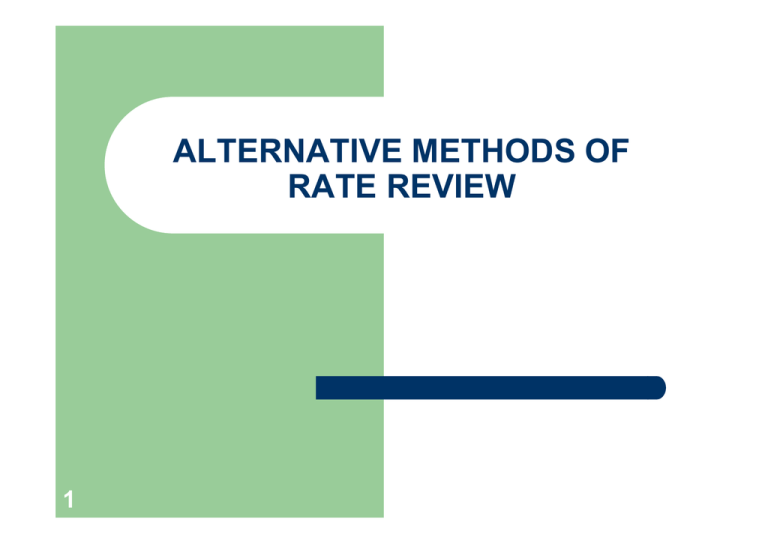ALTERNATIVE METHODS OF RATE REVIEW 1
advertisement

ALTERNATIVE METHODS OF RATE REVIEW 1 GOALS l l l l l 2 Improve the efficiency and performance of the utility Improve incentives and remove disincentives for utility cost reduction Simplify and streamline the regulatory process Maintain a reasonable opportunity for the utility to not only earn a fair rate of return, but extra profits as determined under the performance-based ratemaking plan Maintain and improve quality of service (From: Performance Based Ratemaking: Theory and Practice, Dr. Michael Schmidt, Public Utilities Reports, Inc., 2000) OPERATING RATIO 3 l Operating Expenses / Gross Revenues l Operating Expenses include depreciation and taxes l Shows proportion of annual gross revenues which is required to meet the cost of doing business before compensation of capital OPERATING RATIO l Complement of the operating ratio (the difference between total expenses and gross revenues) is the return margin. – – l l 4 Amount remaining for the payment of a return on investments If operating ratio is 90%, then 10% is available as a return (also referred to as the margin) More capital intensive industries tend to have lower operating ratios, since a larger margin is required to assure that investors receive money on the investment required to fund plant. May be a reasonable alternative when information on investment is unavailable or unreliable TIMES INTEREST EARNED RATIO 5 l Margin + Interest Expense on Long Term Debt Interest Expense on Long Term Debt l Some companies, particularly cooperatives, have strict mortgage requirements tied to TIER and Debt Service Coverage l Regulators have used TIER at a reasonable level over and above the minimum to establish the reasonableness of customer rates CASH FLOW NEEDS l l May be used as a supplemental or stand-alone test to determine necessary level of rates Have generally seen this test used in crisis (rather than normal) situations – – – 6 Example: Company had waited too long to request rate increase, and thus, was having difficulty meeting payroll cash flow needs Example: May be used to keep a company out of bankruptcy by looking at amount needed to keep company from defaulting on loans Example: May be used as an interim (stop-gap) measure while regulators can have more time to study the longer term revenue needs of the utility BENCHMARKING l Compare the results of an individual company to a set of standards or results from other selected companies or overall industry standards – – l Key is in selection of companies to which to compare – 7 Can use for overall (total) costs Can use for a specific, identifiable category Similarly situated or best-of-class PERFORMANCE BASED RATEMAKING l Provide monetary rewards or penalties based on specific, pre-determined performance indicators, such as: – – – – – l l 8 Customer satisfaction Employee safety Outage time Reliability Other? Important to review periodically, and will likely want to increase standard over time May be combined with other methods – especially to make sure that service standards remain high EARNINGS OR COST SHARING l l l A method of sharing the risk of changes in costs and / or earnings A dead band is established as a neutral zone, where price changes do not occur – shareholders take the risk of changes within this established zone Above or below the deadband, changes are shared between customers and shareholders – – 9 Often based on a sliding scale,where the larger the change, the greater the share assigned to customers Sharing may be asymmetric between increases and decreases PRICE CAPS l l l Important to be comfortable with starting rate Rates are reviewed formally only at preset intervals (if at all) Meanwhile, a pre-set, pre-approved formula is used to reflect expected growth in the utility’s input prices, less an allowance for an appropriate rate of productivity gain Current Price + Inflation (or escalation) Factor – Productivity Factor = New Allowed Maximum Price May also be adjusted for external developments that are not expected or outside of utility’s control (e.g., tax rate change) 10 l Below the established cap, the utility has full or partial price freedom PRICE CAPS l Per 1997 National Association of Regulatory Utility Commissioners (NARUC) Report: – – – – 11 Establishing Appropriate Productivity Index may require complicated analysis of industry costs and operating results If designed to achieve one objective, a mechanism could create disincentives in other areas, or may result in unintended consequences Need to review formula over time, and monitor its effectiveness Some objectives are difficult or impossible to meet with a specific pricing mechanism PRICE CAPS – U.K. l British Price – Cap Model:1 PC = Price level ± Inflation ± K Where K is a composite of : Expected Efficiency in the Future Expenditure on Quality Enhancements Efficiency Gains Delivered Enhanced Service Levels Expenditures Supply / Demand Balance Expenditure 1 12 Description courtesy of Jan Beecher, Institute of Public Utilities, beecher@msu.edu. PRICE FLOORS l Wyoming (my home state) has passed a law indicating that the revenues from each service must be at or above the total service long-run incremental cost of providing that service – – – 13 Eliminates implicit subsidies by making each service at least recover its direct cost Prices may exceed the price floor, with regulatory approval and oversight Part of a transitional plan for moving industry from monopoly to competition CONTACT INFORMATION Denise Parrish Dparri@state.wy.us Phone (307) 777-5743 FAX (307) 777-5748 14



